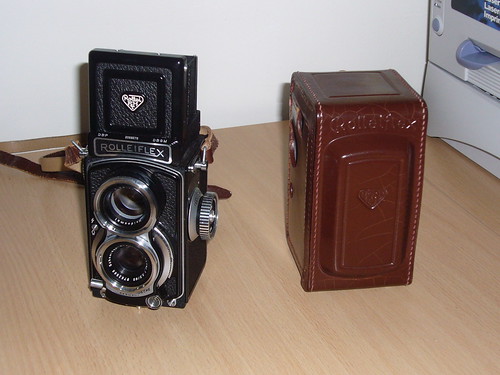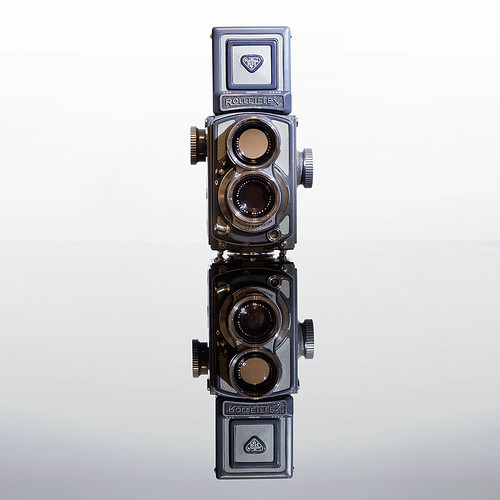Baby Rolleiflex (1957)
| German TLR () | |
|---|---|
| 35 mm | Contaflex | Flexilette | Optima Reflex |
| 3×4 | Pilot Reflex |
| 4×4 | Baby Rolleiflex (1931) | Baby Rolleiflex (1957) | Karma-Flex |
| 6×6 | Altiflex | Amplion Reflex | Brillant | Flektar | Flexo | Flexora | Flexora II | Flexora III | Foth-Flex | Ikoflex 1 | Ikoflex II | Ikoflex Ia | Ikoflex Ic Ikoflex Favorit | Karma-Flex | Mentorett | Montiflex | Peerflekta | Perfekta | Photina Reflex | Plascaflex | Reflecta | Reflekta | Reflekta II | Rica Flex | Rocca Automatic | Rocca Super Reflex | Rolleiflex | Rolleicord | Rollop | Superb | Superflex | Trumpfreflex | Vitaflex | Weltaflex | Wirgin Reflex | Zeca-Flex |
| 6×9 | Superfekta |
The Automatic Rolleiflex 4x4, popularly known as the "Gray Baby" Rolleiflex, was introduced in 1957, at an announced list price of USD $133.65.[1] It is a knob-advance twin-lens reflex yielding 12 exposures of 4x4cm on 127 film. It has a Schneider Xenar 60/3.5 taking lens and a Heidosmat 60/2.8 viewing lens.
This model helped kick-start a brief boom for 38mm × 38mm "super slides" (whose slide mounts were the same external dimensions as 35mm slides, but offering a larger image area), and inspired several Japanese lookalikes such as the Yashica 44.
By 1959 the gray baby's advertised list price had dropped to USD $99.50, [2] perhaps a reflection of waning interest in the format. In 1963 the "gray" was abandoned in favor of "black".
Contents
Specifications
- Rollei internal name : K5
- Production period : 1957 to 1968, 67.180 units
- Format : 12 exposures of 4 x 4 cm on 127 type rollfilm
- Taking lens: Schneider Xenar 1:3.5 f=60mm
- Viewing lens: Heidosmat 1:2.8 f=60mm
- Bayonet Size : Both lenses, size 1
- Shutter: Synchro-Compur MXV CR00 leafshutter. Speeds 1 to 1/500 sec. and B.
- Flash synchronisation : Sync socket on frontpanel. M and X synchronisation
- Color Laqcuer : Gray, from 1963 onwards Black
- Color Leatherette : Gray, from 1963 onwards Black
- Dimensions WxDxH: 64 x 81 x 123 mm
- Weight: 680 grams

|
| Rollei 4x4 Baby, black finish image by Mr Jollybox (Image rights) |

|
| Grey Baby Rollei by Geoffrey Gilson (Image rights) |
Bibliography
- Claus Prochnow, Rollei Report 2, third edition, Braunschweig, Lindemanns Verlag, 2008, ISBN 3-89506-220-0.
Notes
Links
- Rolleiflex 4x4 user manual at Butkus.org
- Baby Rolleiflex at Rolleiclub
- Grey Baby Rollei on www.collection-appareils.fr by Sylvain Halgand (in French)